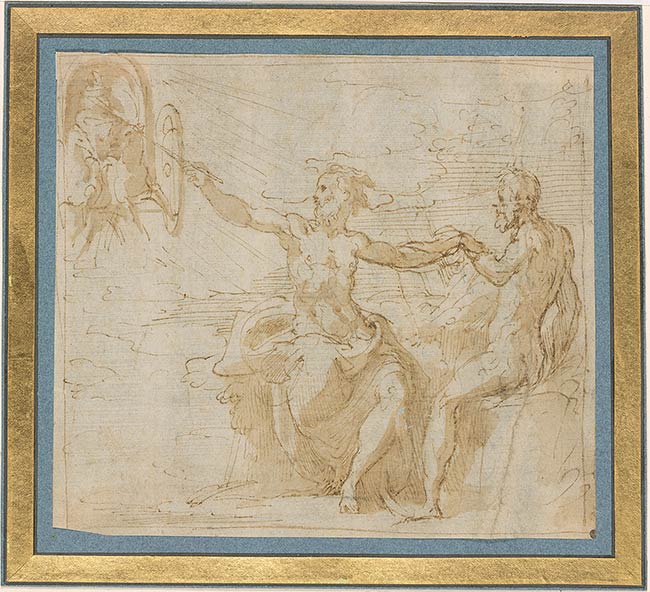
The drawing likely dates to Parmigianino’s stay in Rome in 1524-27. In 1958, Olga Raggio convincingly argued that the subject is inspired by a passage in Boccaccio’s Genealogia deorum gentilium, first published in 1494/95, which equates Prometheus to the Christian God. Of the Morgan drawing, she noted, “a nobly conceived Prometheus, not unlike Michelangelo’s Jehovah, set against a dramatic sky of light and shadow, opens his arms in an all-embracing gesture to reach the sun’s chariot and transfer from it directly the enlivening spark to the clay man who sits in front of him, modeled to his size and image. Perhaps no other visualization of the myth in the Renaissance expresses with greater intensity the peculiar blending of classical, mediaeval and Christian implications that were also created with the figure of Prometheus at this time.”1
The penmanship of the drawing is spare, but also wonderfully loose and free, lightly touched in places with brown wash to create shadows.
Footnotes:
- Raggio 1958, 57.
Watermark: none.
Inscribed on mount in graphite, "1686"; on verso of drawing, top right corner, beneath hinge, in pen and ink, "23".
Denon, Vivant, 1747-1825, former owner.
Lawrence, Thomas, Sir, 1769-1830, former owner.
Barck, Nils, Comte, 1820-1896, former owner.
Murray, Charles Fairfax, 1849-1919, former owner.
Morgan, J. Pierpont (John Pierpont), 1837-1913, former owner.
Morgan, J. P. (John Pierpont), 1867-1943, former owner.
Selected references: Duval 1829, 3: 160; Fairfax Murray 1905-12, 4: no. 45; Ames 1951, no. 33; Raggio 1958, 57; Popham 1971, 1: 124, no. 320; Nijmegen 1983, 13; Boston and elsewhere 1989, 7-8, no. 2; Reed 1991, 70-72; Paris 1999-2000, no. 555; London and New York 2000-01, 144, no. 95; Jacobs 2005, 123; Ekserdjian 2006, 108; Gnann 2007, 1: 396, no. 300; New York 2007, 15.
Amaury Duval, Monuments des Arts du Dessin chez les peuples tant anciens que modernes, recueillis par le Baron Vivant Denon [...] pour servir à l'histoire des arts, lithographiés par ses soins et sous ses yeux, décrits et expliqués par Amaury Duval, 4 vols., Paris, 1829, vol. 3, repr. p. 160.
Charles Fairfax Murray, Collection of Drawings by the Old Masters formed by C. Fairfax Murray (J. Pierpont Morgan Collection), 4 vols., London 1905-1912, vol. 4, no. 45, repr. Six Centuries of Master Drawings, Thirteenth Annual Fine Arts Festival, exh. cat., State University of Iowa, Ames, 1951, no. 33.
Olga Raggio, "The Myth of Prometheus," Journal of the Warburg and Courtauld Institutes 21, 1958, p. 57, pl. 8c.
A. E. Popham, Catalogue of the Drawings of Parmigianino, 3 vols., New Haven, 1971, vol. 1, p. 124, no. 320; vol. 3, pl. 271.
Ronald Tolman, introductory essay, Prometheus beelden en prenten, exh. cat., Museum of the Commanderie of St. Jan, Nijmegen, 1983, p. 13, fig. 3.
Sue Welsh Reed and Richard Wallace, Italian Etchers of the Renaissance & Baroque, exh. cat., Museum of Fine Arts, Boston; Cleveland Museum of Art, Cleveland; and National Gallery of Art, Washington, 1989, pp. 7-8, no. 2, repr.
Sue Welsh Reed, "Giovanni Benedetto Castiglione's God Creating Adam, the Tirst Masterpiece in the Monotype medium," Museum Studies of the Art Institute of Chicago 17, no. 1, 1991, pp. 70-72.
Dominique-Vivant Denon, L'oeil de Napoléon, exh. cat., Musée du Louvre, Paris, 1999-2000, no. 555, repr.
Hugo Chapman and Carmen C. Bambach, Drawings of Correggio and Parmigianino in English and American Collections, exh. cat., British Museum, London, and Metropolitan Museum of Art, New York, 2000-2001, p. 144, no. 95, repr.
Fredrika H. Jacobs, The Living Image in Renaissance Art, Cambridge, United Kingdon, 2005, pp. 123, fig. 41.
Achim Gnann, Parmigianino: Die Zeichnungen, 2 vols., Petersberg, 2007, vol. 1, p. 396, no. 300; vol. 2, repr. p. 262.
Isabelle Dervaux, Drawing connections: Baselitz, Kelly, Penone, Rockburne, and the Old Masters, exh. cat., The Morgan Library & Museum, New York, 2007, p. 15, repr. p. 20.
